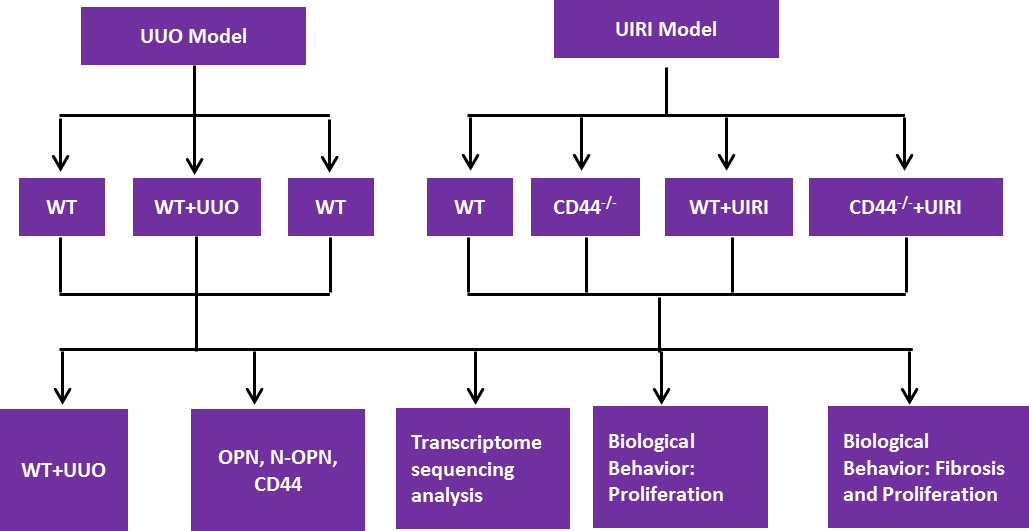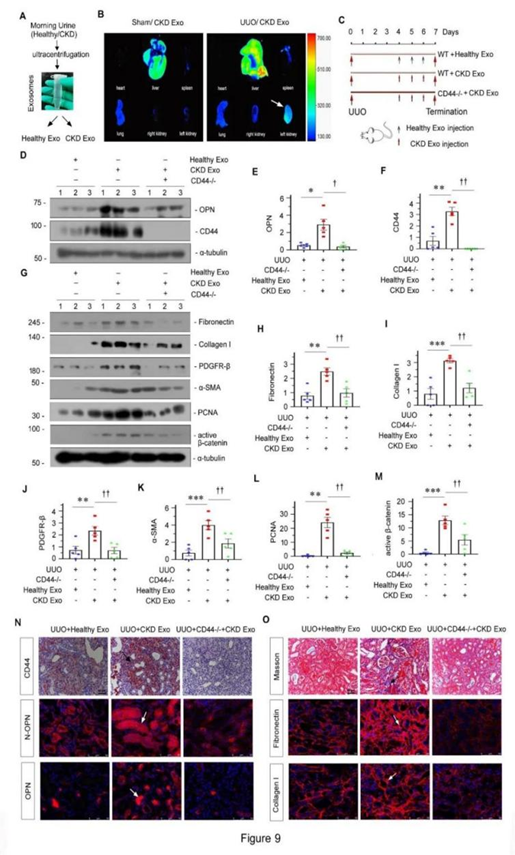
In March 2022, the team of Professor Lili Zhou from Southern Medical University in China published a paper entitled “β-catenin-controlled tubular cell-derived exosomes play a key role in fibroblast activation via the OPN-CD44 axis” in the Journal of Extracellular Vesicles, the top impact factor (IF=25.841) journal in the field of exosome research.
This study found that exosome-mediated activation of the OPN-CD44 signaling axis is controlled by β-catenin signaling and plays a key role in renal fibrosis.

Background
Chronic Kidney Disease (CKD) is characterized by the gradual loss of renal function and progression of renal fibrosis, and is a high-risk factor of end-stage renal disease (ESRD).
Tubular injury and peripheral fibroblast activation are the hallmarks of chronic kidney disease (CKD), suggesting intimate communication between the two types of cells. However, the underlying mechanisms remain to be determined. Exosomes, extracellular vesicles which play a role in shuttling proteins and other materials to recipient cells, may be involved.
Osteopontin (OPN) is an extracellular matrix glyco-phosphoprotein. Through binding with its receptor CD44 and integrin β3, OPN mediates cell adhesion, proliferation, invasion and apoptosis, and plays a role during tissue fibrosis. Full-length OPN has a molecular weight of approximately 70 kDa. In the diseased state, full-length OPN is often cleaved into an N-terminal fragment (∼50 kDa) and two C-terminal fragments (∼18 and ∼16 kDa). N-OPN could be the major active form to trigger a series of pathological changes. However, the role of N-OPN in kidney injury has not yet been investigated. Furthermore, the underlying mechanisms and modulating signals are poorly understood.
Roadmap

Research Finding
To determine the potential role of β-catenin in regulating OPN/CD44 axis signaling in renal fibrosis, researchers generated conditional knockout mice in which the β-catenin gene is specifically disrupted in renal tubules using the Cre-loxP system. Tubule-specific β-catenin conditional knockout mice (Ksp-β-catenin−/−) were created by mating β-catenin floxed mice with Ksp-cre transgenic mice, which were purchased from Cyagen Biosciences. This approach generated a UUO model of renal fibrosis, which was evaluated with western blotting, immunofluorescence, immunohistochemistry, transcriptome sequencing, extraction of exosomes and other methods to confirm that deletion of β-catenin can alleviate renal fibrosis. β-catenin is an effective controller of exosomal OPN/CD44 axis signaling.

Figure 1. Tubule-specific ablation of β-catenin attenuates renal fibrosis through blocking exosomal OPN/CD axis signaling.
To discern the role of CD44 in renal fibrosis, Cyagen constructed global CD44 knockout mice (CD44−/−) for theresearchers. The efficacy of CD44 knockout was confirmed in the UIRI model (one of CKD models) by both immunohistochemistry and western blotting. To test the role of CD44 in renal fibrosis, we used Masson staining, western blotting and immunofluorescence, RNA sequencing to confirm that knockout of CD decreases kidney fibrosis in the UIRI model.

Figure 2. Knockout of CD44 decreases kidney fibrosis in UIRI model. [5]
The CD44 null mice (CD44−/−) aged 6–8 weeks, on a C57BL/6N background, were also sourced from Cyagen Biosciences.
In a previous study, the research team found that renal tubule-derived exosomes can induce fibroblast activation through Shh signaling and lead to renal fibrosis [4]. In this study, we continued to explore the role of tubular-derived exosomes in renal fibrosis, and found that tubular cell-derived exosomes, OPN, played a central role in promoting renal fibrosis through CD44 signaling.

Figure 3. Tubular cell-derived exosomal OPN plays a central role in promoting renal fibrosis. [5]
Summary
With tubule-specific β-catenin conditional knockout mice (cKO mice) and CD44 knockout mice, the study reveals the mechanism of β-catenin regulating OPN/CD44 axis signaling in renal fibrosis. β-catenin is a master controller for tubular cells and interstitial fibroblast communication, which promotes exosome secretion and OPN expression in injured tubular cells. OPN is encapsulated in tubular cell-derived exosomes, and then transferred to interstitial fibroblasts and induces myofibroblast activation through binding to its receptor CD44, and urinary N-OPN serves as an indicative marker for CKD progression and renal fibrosis.

Figure 4. Working model. The schematic presentation depicts the potential mechanism by which exosomal OPN/CD44 axis meditates renal fibrosis.
1. Guan, H., et al. 2020. Injured tubular epithelial cells activate fibroblasts to promote kidney fibrosis through miR-150-containing exosomes. Experimental Cell Research.
2. Bai, G., et al. 2020. Stimulation of THP-1 Macrophages with LPS Increased the Production of Osteopontin-Encapsulating Exosome. Int J Mol Sci.
3. Kaleta, B. 2019. The role of osteopontin in kidney diseases. Inflamm Res.
4. Liu X, et al. 2020. Tubule-derived exosomes play a central role in fibroblast activation and kidney fibrosis. Kidney Int.
5. Shuangqin Chen, et al. 2022. β-catenin-controlled tubular cell-derived exosomes play a key role in fibroblast activation via the OPN-CD44 axis. Journal of Extracellular Vesicles.
We will respond to you in 1-2 business days.